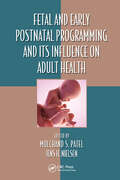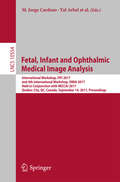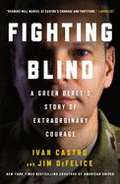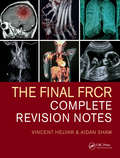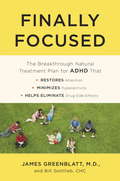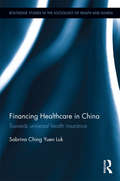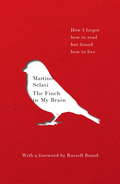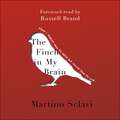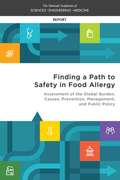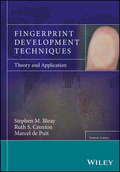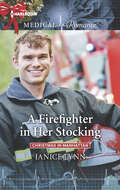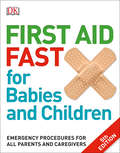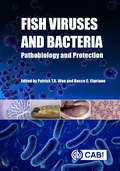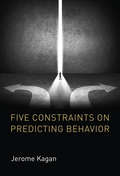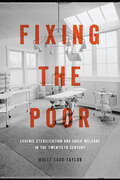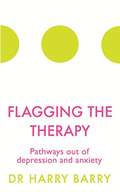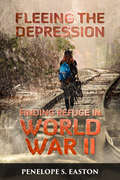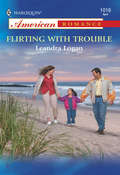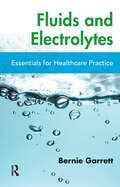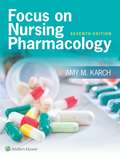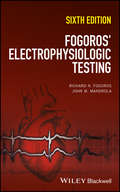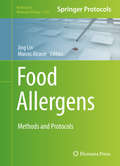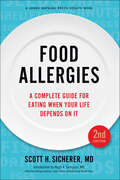- Table View
- List View
Fetal and Early Postnatal Programming and its Influence on Adult Health (Oxidative Stress and Disease)
by Mulchand S. Patel Jens H. NielsenThere is a documented link between fetal nutrition and the development of disease risk in adult life. Including the early postnatal period, during which a newborn continues to grow rapidly influenced by environmental factors, suggests that individuals are subject to risks for more than just the fetal period. Fetal and Early Postnatal Programming and its Influence on Adult Health focuses on interrelated aspects of cellular programming related to early nutrition and this potential global health problem.
Fetal, Infant and Ophthalmic Medical Image Analysis: International Workshop, FIFI 2017, and 4th International Workshop, OMIA 2017, Held in Conjunction with MICCAI 2017, Québec City, QC, Canada, September 14, Proceedings (Lecture Notes in Computer Science #10554)
by M. Jorge Cardoso, Tal Arbel, Andrew Melbourne, Hrvoje Bogunovic, Pim Moeskops, Xinjian Chen, Ernst Schwartz, Mona Garvin, Emma Robinson, Emanuele Trucco, Michael Ebner, Yanwu Xu, Antonios Makropoulos, Adrien Desjardin and Tom VercauterenThis book constitutes the refereed joint proceedings of the International Workshop on Fetal and Infant Image Analysis, FIFI 2017, and the 6th International Workshop on Ophthalmic Medical Image Analysis, OMIA 2017, held in conjunction with the 20th International Conference on Medical Imaging and Computer-Assisted Intervention, MICCAI 2017, in Québec City, QC, Canada, in September 2017. The 8 full papers presented at FIFI 2017 and the 20 full papers presented at OMIA 2017 were carefully reviewed and selected. The FIFI papers feature research on advanced image analysis approaches focused on the analysis of growth and development in the fetal, infant and paediatric period. The OMIA papers cover various topics in the field of ophthalmic image analysis.
Fighting Blind: A Green Beret's Story Of Extraordinary Courage
by Ivan Castro Jim DeFelice Ivan Castro and Jim DeFeliceFighting was a practiced routine for Lieutenant Ivan Castro. But when a mortar round struck the rooftop of his sniper’s post in Iraq, he found himself in a battle more difficult than even he could have imagined. The direct hit killed two other soldiers and nearly claimed Castro’s life as well. Mangled by shrapnel and badly burned, Castro was medevac’d to Germany more dead than alive. His lungs were collapsed. He couldn’t hear. One eye had been blown out, the nerve to the other severed. In the weeks and months that followed, Castro would find that physical darkness was nothing compared to the emotional darkness of loss and despair. Desperate for a reason to live, he eventually fought his way back to health through exercise and a single-minded goal: running a marathon. Once he set his course, there was no stopping him. Stubborn to a point that at times bordered on insanity, he managed not only to recover but to return to active duty. Since 2007, he has run over two dozen marathons, including the Boston Marathon in 2013, where he was one of the runners diverted when the bombs exploded. Today, Castro helps prepare soldiers for combat, working exactly as if he were “sighted.” Fighting Blind, this frankly told account of his struggle through adversity, the highs and lows and the always bumpy road in between, is a story of hope and perseverance against the odds: an Unbroken for the present generation.
The Final FRCR: Complete Revision Notes
by Vincent Helyar Aidan ShawThis is a vital revision aid for postgraduate radiology students taking the Fellowship of the Royal College of Radiology (FRCR) Part 2 final exams. Part 2 comprises two elements: 2a includes a series of six multiple choice exams covering the major body systems, and 2b contains a written exam and an oral viva typically taken at the beginning of the fourth year of specialty training.
Finally Focused: The Breakthrough Natural Treatment Plan for ADHD That Restores Attention, Minimizes Hyperactivity, and Helps Eliminate Drug Side Effects
by James Greenblatt Bill GottliebDISCOVER THE ADHD SOLUTION FOR YOUR CHILDDr. James Greenblatt has seen thousands of children and adults struggling with the symptoms of ADHD – hyperactivity, inattentiveness, impulsiveness, and often irritability and combativeness. Rather than simply prescribing medication for their ADHD symptoms, he tailors remedies to his patients’ individual needs, detecting and treating the underlying causes of the disorder. Finally Focused provides proven natural and medical methods to easily treat problems such as nutritional deficiencies or excesses, dysbiosis (a microbial imbalance inside the body), sleeping difficulties, and food allergies, all of which surprisingly can cause or worsen the symptoms of ADHD. Using Dr. Greenblatt’s effective Plus-Minus Healing Plan, parents will first understand the reasons behind their child's symptoms, and then be able to eliminate them by addressing the child’s unique pattern of biological weakness. Adults with ADHD can do the same for themselves. And if conventional medication is still necessary, this integrative approach will minimize or even eliminate troublesome side effects. Using Dr. Greenblatt’s expert advice, millions of children and adults with ADHD finally will get the help they need to achieve true wellness.
Financing Healthcare in China: Towards universal health insurance
by Sabrina Ching LukChina’s current social medical insurance system has nominally covered more than 95 per cent of 1.4 billion population in China and is moving towards the ambitious goal of universal health insurance coverage. Challenges posed by a rapidly ageing population, an inherently discriminatory design of the health insurance system, the disorder of drug distribution system and an immature legal system constrain the Chinese government from realizing its goal of universal health insurance coverage in the long run. This book uses a refined version of historical institutionalism to critically examine China's pathway to universal health insurance coverage since the mid-1980s. It pays crucial attention to the processes of transforming China's healthcare financing system into the basic social medical insurance system alongside rapid socio-economic changes. Financing Healthcare in China will interest researchers and government and think-tank officials interested in the state of healthcare reforms in China. Healthcare specialists outside of East Asia may also be interested in its general study of healthcare in developing countries. Scholars and students interested in the healthcare field will also find this useful.
The Finch in My Brain: How I forgot how to read but found how to live
by Martino Sclavi'Whenever I see Martino I am reminded of how little I know about life and death compared to him. How we don't know what is within us or what may lie on the other side. I hope it's as magical and beautiful as this book.' --Russell BrandWhen film producer Martino Sclavi began experiencing intense headaches, he attributed them to his frenetic lifestyle. As it turned out, he had grade 4 brain cancer and was given 18 months to live. After undergoing brain surgery - while awake - Martino found he had lost the ability to recognise words. His response was to close his eyes and begin to move his fingers across the keyboard to write this, an account of life before diagnosis and since. Defying all predictions Martino is still very much alive, words read out to him by the monotone of a computerised voice he calls Alex. But he must now live in a new way. This book - that he has written but cannot read - charts the effects of his experience: on his relationship with his young son, his marriage, his work and with himself. In the wake of his illness, everything must be reconfigured and Martino is made to question the habits, dreams and beliefs of his old life and confront the present. What he finds is strange and beautiful. Searching for the words between life and death, Sclavi shows that with determination and a subtle, persistent sense of humour, it is possible to change the story of our lives.
The Finch in My Brain: How I forgot how to read but found how to live
by Martino Sclavi'It's eerily joyful to write a foreword for Martino Sclavi's book because five years ago I accepted that he was going to die.' Russell Brand. Diagnosed with fatal brain cancer, the treatment that follows renders the writer of this extraordinary memoir unable to recognise words. This is the inspiring story he can no longer read. With a foreword by Russell Brand.This is the story of a successful Italian-born, London-based film writer who is suddenly, wholly unexpectedly diagnosed with stage four brain cancer. The prognosis is bad: there's a 98% likelihood he'll be dead within 18 months. He undergoes two operations, including one in which he must remain awake throughout. Part of his brain is removed, the part that enables us to recognise written words - to read. As someone who relies on words for their livelihood, their very identity, this presents impossible questions as to what happens next. Defying all predictions, Martino is still very much alive five years on, and is writing and being read to by a monotonous computerised voice he calls Alex. His marriage suffered, his relationship with his young son - whom he will never read bedtime stories to again - must be reconfigured and he is made to question all that his previous life gave him, along with his habits, dreams and beliefs.As Sclavi faces the reality of the narrative he's been presented by doctors, he shows us that with determination, it is possible to change that narrative, and in doing so inspires and empowers us all to believe that it is possible to change the story of our lives.'Whenever I see Martino I am reminded of how little I know about life and death compared to him. How we don't know what is within us or what may life on the other side. I hope it's as magical and beautiful as this book.'Russell Brand.(P)2017 Hodder & Stoughton Limited
Finding a Path to Safety in Food Allergy: Assessment of the Global Burden, Causes, Prevention, Management, and Public Policy
by National Academies of Sciences Engineering MedicineOver the past 20 years, public concerns have grown in response to the apparent rising prevalence of food allergy and related atopic conditions, such as eczema. Although evidence on the true prevalence of food allergy is complicated by insufficient or inconsistent data and studies with variable methodologies, many health care experts who care for patients agree that a real increase in food allergy has occurred and that it is unlikely to be due simply to an increase in awareness and better tools for diagnosis. Many stakeholders are concerned about these increases, including the general public, policy makers, regulatory agencies, the food industry, scientists, clinicians, and especially families of children and young people suffering from food allergy. At the present time, however, despite a mounting body of data on the prevalence, health consequences, and associated costs of food allergy, this chronic disease has not garnered the level of societal attention that it warrants. Moreover, for patients and families at risk, recommendations and guidelines have not been clear about preventing exposure or the onset of reactions or for managing this disease. Finding a Path to Safety in Food Allergy examines critical issues related to food allergy, including the prevalence and severity of food allergy and its impact on affected individuals, families, and communities; and current understanding of food allergy as a disease, and in diagnostics, treatments, prevention, and public policy. This report seeks to: clarify the nature of the disease, its causes, and its current management; highlight gaps in knowledge; encourage the implementation of management tools at many levels and among many stakeholders; and delineate a roadmap to safety for those who have, or are at risk of developing, food allergy, as well as for others in society who are responsible for public health.
Fingerprint Development Techniques: Theory and Application (Developments in Forensic Science)
by Stephen M. Bleay Ruth S. Croxton Marcel De PuitA comprehensive review of the latest fingerprint development and imaging techniques With contributions from leading experts in the field, Fingerprint Development Techniques offers a comprehensive review of the key techniques used in the development and imaging of fingerprints. It includes a review of the properties of fingerprints, the surfaces that fingerprints are deposited on, and the interactions that can occur between fingerprints, surfaces and environments. Comprehensive in scope, the text explores the history of each process, the theory behind the way fingerprints are either developed or imaged, and information about the role of each of the chemical constituents in recommended formulations. The authors explain the methodology employed for carrying out comparisons of effectiveness of various development techniques that clearly demonstrate how to select the most effective approaches. The text also explores how techniques can be used in sequence and with techniques for recovering other forms of forensic evidence. In addition, the book offers a guide for the selection of fingerprint development techniques and includes information on the influence of surface contamination and exposure conditions. This important resource: Provides clear methodologies for conducting comparisons of fingerprint development technique effectiveness Contains in-depth assessment of fingerprint constituents and how they are utilized by development and imaging processes Includes background information on fingerprint chemistry Offers a comprehensive history, the theory, and the applications for a broader range of processes, including the roles of each constituent in reagent formulations Fingerprint Development Techniques offers a comprehensive guide to fingerprint development and imaging, building on much of the previously unpublished research of the Home Office Centre for Applied Science and Technology.
A Firefighter in Her Stocking: Sleigh Ride With The Single Dad A Firefighter In Her Stocking A Christmas Miracle (Christmas in Manhattan #2)
by Janice LynnA gift impossible to resist!When a firefighter rushes a child into her ER, Dr. Sarah Grayson is stunned that the ash-covered, exhausted hero is her incorrigible playboy neighbor, Jude Davenport!Sarah is wary of such men, but when gorgeous Jude suggests a Christmas fling, she can’t resist. Yet their relationship deepens, and Sarah sees behind the playboy is a man who has loved and lost. He might try to keep his emotions on ice, but Sarah begins to wonder—could she be the one to heal his damaged heart?
First Aid Fast for Babies and Children: Emergency Procedures for all Parents and Caregivers
by DKDo you know what to do if your baby or child falls and cuts their arm? Are you confident to identify when an illness is serious?First Aid Fast for Babies and Children is a step-by-step guide that helps you treat babies and children for more than 100 conditions and injuries. This book guides you through essential initial care that can prove tremendously important to preserve life and improve the recovery process. The detailed guidelines are accompanied by step-by-step images for clear, easy-to-follow instructions. From first aid for cuts and bruises to treating a child who is unresponsive, this book covers all emergency situations that you may face. Clear symbols highlight key areas and draw your attention to areas of concern. The cross-reference boxes on a page take you to associated information regarding the injuries.This clear and informative guide is ideal for parents, teachers, and primary caregivers to help deal with emergencies. Look after your little people – keep First Aid Fast for Babies and Children handy.
Fish Oil: How this natural healer can help arthritis, skin disorders and encourage better health (Wellbeing Quick Guides)
by Liz EarleLiz Earle looks at the latest research into Britain's most popular health supplement and explains how it can be used to relieve a variety of ailments, including arthritis, psoriasis and eczema.Bestselling beauty and wellbeing writer Liz Earle's fully revised and updated quick guide to cod liver oil, including:- The history of the oil and its legendary properties- How essential fatty acids work- The latest research into the oil for arthritis - How it helps the skin (including eczema and psoriasis problems)- A dosage guide for the family
Fish Viruses and Bacteria
by Patrick T.K. Woo Rocco C. CiprianoTaking a disease-based approach, Fish Viruses and Bacteria: Pathobiology and Protection focuses on the pathobiology of and protective strategies against the most common, major microbial pathogens of economically important marine and freshwater fish. The book covers well-studied, notifiable piscine viruses and bacteria, including new and emerging diseases which can become huge threats to local fish populations in new geographical regions if transported there via infected fish or eggs. A concise but thorough reference work, this book: - Covers key viral and bacterial diseases of notable fish species; - Reviews major well-established piscine pathogens as well as new, emerging and notifiable diseases; and - Contains the most up-to-date research contributed by a team of over fifty world experts. An invaluable bench book for fish health consultants, veterinarians and all those wanting instant access to information, this book is also a useful textbook for students specializing in fish health and research scientists initiating fish disease research programmes.
Five Constraints on Predicting Behavior
by Jerome KaganA distinguished psychologist considers five conditions that constrain inferences about the relation between brain activity and psychological processes. Scientists were unable to study the relation of brain to mind until the invention of technologies that measured the brain activity accompanying psychological processes. Yet even with these new tools, conclusions are tentative or simply wrong. In this book, the distinguished psychologist Jerome Kagan describes five conditions that place serious constraints on the ability to predict mental or behavioral outcomes based on brain data: the setting in which evidence is gathered, the expectations of the subject, the source of the evidence that supports the conclusion, the absence of studies that examine patterns of causes with patterns of measures, and the habit of borrowing terms from psychology. Kagan describes the important of context, and how the experimental setting—including the room, the procedure, and the species, age, and sex of both subject and examiner—can influence the conclusions. He explains how subject expectations affect all brain measures; considers why brain and psychological data often yield different conclusions; argues for relations between patterns of causes and outcomes rather than correlating single variables; and criticizes the borrowing of psychological terms to describe brain evidence. Brain sites cannot be in a state of “fear.” A deeper understanding of the brain's contributions to behavior, Kagan argues, requires investigators to acknowledge these five constraints in the design or interpretation of an experiment.
Fixing the Poor: Eugenic Sterilization and Child Welfare in the Twentieth Century
by Molly Ladd-TaylorHow state welfare politics—not just concerns with "race improvement"—led to eugenic sterilization practices.Honorable Mention, 2018 Outstanding Book Award, The Disability History AssociationShortlist, 2019 Wallace K. Ferguson Prize, Canadian Historical AssociationBetween 1907 and 1937, thirty-two states legalized the sterilization of more than 63,000 Americans. In Fixing the Poor, Molly Ladd-Taylor tells the story of these state-run eugenic sterilization programs. She focuses on one such program in Minnesota, where surgical sterilization was legally voluntary and administered within a progressive child welfare system.Tracing Minnesota's eugenics program from its conceptual origins in the 1880s to its official end in the 1970s, Ladd-Taylor argues that state sterilization policies reflected a wider variety of worldviews and political agendas than previously understood. She describes how, after 1920, people endorsed sterilization and its alternative, institutionalization, as the best way to aid dependent children without helping the "undeserving" poor. She also sheds new light on how the policy gained acceptance and why coerced sterilizations persisted long after eugenics lost its prestige. In Ladd-Taylor's provocative study, eugenic sterilization appears less like a deliberate effort to improve the gene pool than a complicated but sadly familiar tale of troubled families, fiscal and administrative politics, and deep-felt cultural attitudes about disability, dependency, sexuality, and gender. Drawing on institutional and medical records, court cases, newspapers, and professional journals, Ladd-Taylor reconstructs the tragic stories of the welfare-dependent, sexually delinquent, and disabled people who were labeled "feebleminded" and targeted for sterilization. She chronicles the routine operation of Minnesota's three-step policy of eugenic commitment, institutionalization, and sterilization in the 1920s and 1930s and shows how surgery became the "price of freedom" from a state institution. Combining innovative political analysis with a compelling social history of those caught up in Minnesota's welfare system, Fixing the Poor is a powerful reinterpretation of eugenic sterilization.
Flagging the Therapy: Pathways out of depression and anxiety (The Flag Series #3)
by Dr Harry Barry'Mandatory reading for all those who have the slightest interest in good health and human happiness SUNDAY INDEPENDENTA practical, step-by-step guide to identify and cope with depression by bestselling author and GP Dr Harry Barry. Depression and anxiety can have a debilitating effect on sufferers and their families. However, in many cases, these afflictions can be treated and risks of recurrence significantly reduced. Applying a system using colour-coded flags for various mental states and problems, Dr Barry explains the role our minds and brains play in the manifestation of depression and anxiety, and how these in turn can be shaped to lead us out of illness. Flagging the Therapy uses relatable case studies and examines the numerous medical, psychological and complimentary therapies that can all help in negotiating a pathway out of depression and anxiety.Previously published as Flagging the Therapy: Pathways Out of Depression and Anxiety, this edition has been fully revised and updated.
Fleeing the Depression: Finding Refuge in World War II
by Penelope S. EastonFleeing the Depression: Finding Refuge in World War II chronicles the adventures of a small town girl defying 2Oth century rules to become a strong, independent woman. Growing up, Penelope heard the older women’s euphemisms about sex and mating. Never satisfied with empty explanations, she read her physician father’s anatomy books to learn the truth about female bodies. Later, as a dietetic intern at one of the Army’s biggest hospitals, she learned the language of combat soldiers and the horrors of war. Penelope’s curiosity, sense of humor, and fearlessness emboldened her as she traveled a man’s world and, through her actions and ways, helped pioneer the contours that define modern-day feminism.Through [Easton'] stories that foretold her future, we find a likable girl who survived and thrived in a world that was not always kind to her... Any women can identify with the stories that did not always provide the respect that women deserved in the 20th Century. -- Deborah Tippett, Ph.D. Professor, Human Environmental Sciences, Meredith College, Raleigh, NC
Flirting With Trouble
by Leandra LoganCan A High-Society Girl Give Up Life In The Fast Lane For Love In Fairlane? Shop-till-you-drop socialite Amanda Pierpoint is the New York gossip columnist everyone's gossiping about. Trying to please her father, she's almost ready to settle down — until Pierpoint Sr., the media mogul, goes too far. He's picked her future husband with less thought than he gives to his after-dinner cigar! Obviously it's time to get out of town. A pair of dark glasses and a dye job later, she's on the run — to a small dot on the map named Fairlane, where she causes a traffic mishap while ogling "Handsome" Hanson's taut muscles glistening in the noonday sun. Dr. Brett, as the locals call him, has secrets, too — his precocious daughter, ex-wife and red Corvette are all part of a hush-hush past. But their boardinghouse roomies are looking for intrigue. "Handsome" and Amanda falling for each other? That's perfect! Of course, when her father arrives with fiance in tow, her cover's blown and the truth comes out. Now what will the publicity-shy doctor do?
Flow Cytometry in Neoplastic Hematology: Morphologic-Immunophenotypic Correlation, Third Edition
by Wojciech GorczycaThis third edition is the product of the author’s 25 years of experience with flow cytometry; although it covers the wide spectrum of hematopoietic tumors, the focus remains on most important clinical diagnoses, such as acute promyelocytic leukemia, identification of blasts, identification of clonal B-cell population, differentiating mature versus immature T-cell proliferations, deferential diagnosis between hematogones and B-ALL or distinction between chronic and acute monocytic proliferations. All hematopathologists and neoplastic hematologists will find this an important resource for keeping up to date with developments in clinical practice.
Fluids and Electrolytes: Essentials for Healthcare Practice
by Bernard M. GarrettFluids and Electrolytes: Essentials for Healthcare Practice is designed to give a solid understanding of fluid and electrolyte physiology and its implications for practice, including acid-base balance and intravenous (IV) therapy, in a concise and easily understandable format. Chapters incorporate physiological, developmental and practical aspects, highlighting some of the key issues that arise from childhood to old age. This accessible text is presented with clear graphical representations of key processes, numerous tables and contains interesting facts to explore some common myths about human fluid and electrolyte physiology. A valuable resource for healthcare students, this book also provides a strong comprehensive overview for practitioners, nurses, physiotherapists and paramedics.
Focus on Nursing Pharmacology
by Amy M. Karch Rn CnsThis proven resource reviews and integrates students' baseline knowledge of physiology, pathophysiology, chemistry, and nursing fundamentals into chapters focused on "need to know" concepts about each group of drugs. Reflecting the most recent advances in the field, this concise and beautifully illustrated book organizes essential nursing pharmacology information into easy-to-learn steps.
Fogoros' Electrophysiologic Testing
by Richard N. Fogoros John M. MandrolaThe classic guide to applying, performing and interpreting EP tests, updated for the latest trends and developments in the field For more than thirty years, Electrophysiologic Testing has been a trusted introduction to the field of electrophysiology for anyone needing to quickly acquaint themselves with basic concepts and procedures of EP testing, especially medical students, residents, nurses and technicians. At the same time, it also has served as a ready reference for medical practitioners wanting to brush up on aspects of electrophysiology, or to fine-tune their mastery of the field. Updates and additions featured in the Sixth Edition of this classic guide include extensive new material on the ablation of cardiac arrhythmias, including new chapters on the ablation of atrial fibrillation, typical and atypical atrial flutters and ventricular arrhythmias. The ultimate guide to applying, performing and interpreting EP tests to optimise the treatment of patients with cardiac arrhythmias, Electrophysiologic Testing, Sixth Edition: Clarifies the role of electrophysiology in the evaluation of cardia arrhythmias Provides clear summaries of complex topics Features a uniquely user-friendly style that makes information easy to digest and recall Offers clear, step-by-step guidance on performing EP tests and interpreting their results Reviews the latest developments in therapeutic electrophysiology As with all previous editions, this updated and revised Sixth Edition was written with the goal of demystifying electrophysiology, and making it readily accessible to virtually anyone with a professional need. To that end, Drs. Fogoros and Mandrola have once again turned in a masterful performance.
Food Allergens
by Jing Lin Marcos AlcocerThis volume provides a collection of methodologies for basic research, clinical diagnosis, and treatment pertaining to food allergens, including food allergen production, purification, characterization, detection, quantification, and bioinformatics approaches to modern food allergen studies. The chapters in the book are divided into 4 parts: Part I discusses food allergen purification and production, and explores methods of producing recombinant food allergens in bacterial and yeast expression systems; Part II looks at allergen discovery, detection, and quantification covering 3 types of methods--DNA-, protein-, and cell-based methods; Part III focuses on allergenic epitope mapping; and Part IV talks about future developments concentrated around new concepts of allergenicity as an outcome of protein and food matrix interactions. Written in the highly successful Methods in Molecular Biology series format, chapters include introductions to their respective topics, lists of the necessary materials and reagents, step-by-step, readily reproducible laboratory protocols, and tips on troubleshooting and avoiding known pitfalls. Cutting-edge and comprehensive, Food Allergens: Methods and Protocols is a valuable resource for immunologists, biochemists, molecular biologists, and medical doctors and students working in the food allergy field. This book is also useful for people in the food industry, legislators, food standard agencies, allergologists, pediatricians, and clinicians in the allergic diseases and immunology fields.
Food Allergies: A Complete Guide for Eating When Your Life Depends on It (A Johns Hopkins Press Health Book)
by Scott H. SichererThe essential guide for anyone who suffers from food allergies.Posing the urgent questions that anyone with food allergies will think to ask—and then some—Food Allergies provides practical, sensitive, and scientific guidance on the topics that affect your life. Allergy expert Scott H. Sicherer addresses the full spectrum of food allergies, from mild to life threatening and from single foods to food families, clearing up misconceptions along the way. He explores how exposure to foods can bring about an allergic response, describes the symptoms of food allergy, and illuminates how food allergies develop.Organized in an accessible Q&A format and illustrated with case studies, the book thoroughly explains how to prevent exposure to a known allergen at home, at school, in restaurants, and elsewhere. Dr. Sicherer also gives valuable advice about what to do if exposure occurs, including how to handle an anaphylactic emergency. Finally, he describes tests for diagnosing food allergies and chronic health problems caused by food allergies, such as eczema, hives, and respiratory and gastrointestinal symptoms.In this thoroughly updated new edition, Dr. Sicherer• describes new approaches to prevent food allergies• presents cutting-edge theories on risk factors for developing food allergies• describes innovative allergy tests to improve diagnosis• explains how to administer emergency medications for severe reactions• focuses on new allergens of concern, such as pink peppercorns• analyzes studies suggesting that resolution of an allergy might be predictable• talks about the role of "healthy diet"• lists additional resources, including allergy-related apps• provides revised school food allergy guidelines• offers insights into food allergy bullying—and advice to reduce itDr. Sicherer also reviews food reactions that are not allergic (such as lactose intolerance and celiac disease), advises how to get adequate nutrition when you must avoid dietary staples, and discusses whether allergies ever go away (they do—and sometimes they return).
